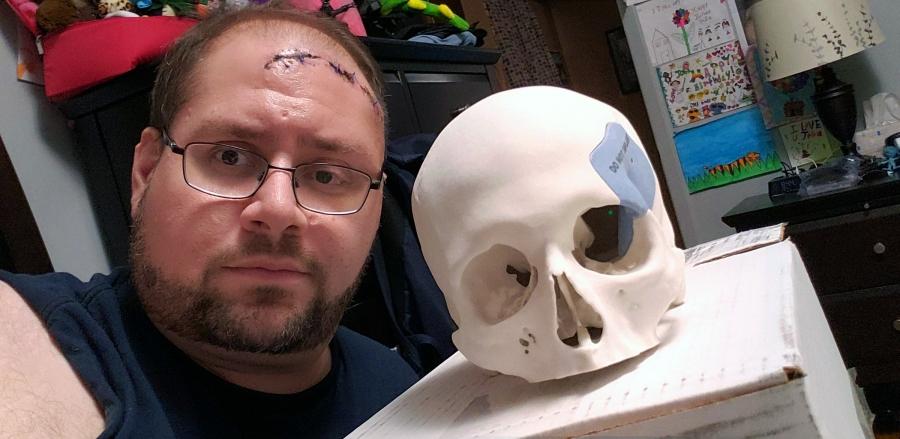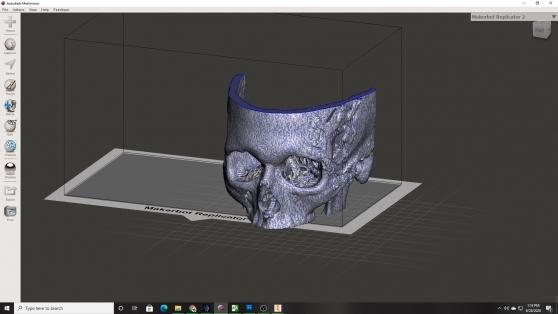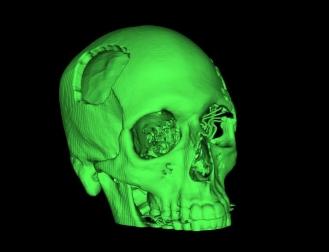Using his head

Staten Island Technical HS teacher Joe Buro with the 3D replica of his skull that he uses in his computer-aided design class.
He taught it. Now Joseph Buro is living it. For the last five years, Buro has been leading his 3D computer-aided design class at Staten Island Technical HS in an exercise to repair a skull in surgery, using a random CAT scan of a repaired skull that Buro found online. Students are tasked with replicating the patch and then Buro prints it out in 3D to see if it’s an accurate match for the hole.
Little did Buro know that he was walking his students through the kind of surgery he would one day experience — and that he would use images of his own CAT scan for their remote teaching lessons. In November 2019, Buro underwent surgery at Staten Island University Hospital North to remove noncancerous tissue growing inside the bone of his skull, which was compromising his left temple and the surrounding area. The tissue was tied to radiation treatments for leukemia Buro received as a teenager.
The exercise he taught in class was the same one doctors used to repair his skull. Surgeons used a semi-crystalline thermoplastic that mimics bone to create a 3D printed plastic patch to repair the hole in Buro’s skull. But that was only the first patch. He had three more cranial surgeries to halt a bleed, to remove infected skull tissue and then to patch the new hole where the infected tissue had been.

The printable model of his skull, which used Buro’s CAT scan data.

“They drilled hundreds and hundreds of holes in my skull,” said Buro. “They had to be precise to get the diseased bone tissue, even using small bone saws.”
His last surgery was on March 5, 2020. Buro now has two 3D printed implants on the sides of his skull, and titanium mesh forms the side of his left eye socket.
Buro kept his friends and colleagues up to date on Facebook and let them know he was in on the joke: “For those of you that know how I teach a bit of Biomedical Engineering at Staten Island Tech in my Computer-Aided Design class, you are probably smiling right now about how I can use my own head as an assignment in my class,” Buro wrote in a Facebook post. “Yes, it is pretty ironic that I have a 3D printed implant in my skull. My neurosurgeon has fed my fascination in addition to saving my life. She gave me the model of my own skull and the preview implant designed by the Biotech company that made the implant for my case.”
Because of COVID-19, Buro got back to teaching faster than he thought he would. He originally took medical leave through the end of June 2020, but the pandemic gave him the ability to work remotely from April through June.
“Now I use my own CAT scan data,” he said. “It’s really something.”
Students are speechless when they hear his story and see the scans, Buro said. “It’s definitely inspired a lot of people to get fully invested in biomedical engineering.”
One student even made a model of a prosthetic leg for his dog.
Many students take computer-aided design classes for careers in architecture and engineering, but bio-medical engineering uses the same techniques to create not just skull patches but prosthetic hands, heart valves and even pacemakers. “Biomedical engineering is about repairing the body in any way,” said Buro, who has been teaching for 17 years and is a 1999 alumnus of the school.
“He is masterful with the computer-aided design program,” said Staten Island Technical HS Chapter Leader Ray Ferrigno. “He brings it to life for the kids, which is what all good teachers do.”
Everton Henriques, a fellow teacher at Staten Island Technical HS, calls Buro “an exemplary teacher.”
“He’s in it to win it,” Henriques said. Buro’s creativity and drive came through during his presentation at Math for America, an organization with a Master Teacher fellowship program that establishes a STEM (science, technology, engineering and mathematics) teacher community where ideas are shared and teachers learn from each other.
“One of the highlights was Buro showing exact images of his surgery,” said Henriques. “This was in the fall of 2019. He still had staples in his head.” Buro still marvels at the coincidence of it all.“ It’s ironic and strange how all this happened to me,” he said.